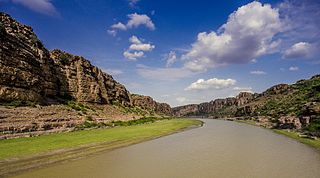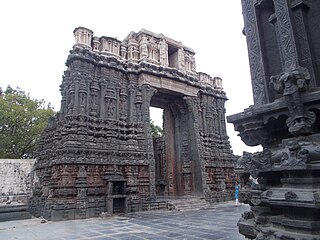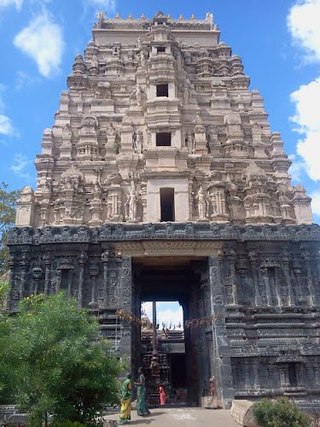Kamma is a largely Hindu caste from South India. The community of Kammas is believed to have originated from agriculturists of the Kammanadu region of the erstwhile Guntur district and Ongole division in Andhra Pradesh. Propelled by their military activity in the Vijayanagara Empire, Kammas are believed to have spread out from the region during the Vijayanagara period, followed by some in-migration during the British period and out-migration again during the twentieth century. Today they are regarded as one of the richest groups in Andhra Pradesh and are a dominant caste from Coastal Andhra with socio-economic and political prominence throughout the Telugu-speaking regions of India.
Naidu is a Telugu title commonly used by various Telugu castes. 'Nayudu/Naidu' (నాయుడు) is a contraction of the Telugu word 'Nayakudu' (నాయకుడు) meaning leader, chief, or headman. Telugu castes such as the Kapu/Balija Kamma, Gavara, Golla, Turpu Kapu, Velama, Boya among others use this title. In Coastal Andhra, the term Naidu primarily refers to Kapu caste.

Krishnadevaraya was an emperor of the Vijayanagara Empire reigning from 1509 to 1529. He was the third monarch of the Tuluva dynasty, and is considered to be one of the greatest rulers in Indian history. He ruled the largest empire in India after the fall of the Islamic Delhi Sultanate. Presiding over the empire at its zenith, he is regarded as an icon by many Indians. Krishnadevaraya earned the titles Andhra Bhoja, Karnatakaratna Simhasanadeeshwara, Yavana Rajya Pratistapanacharya, Kannada Rajya Rama Ramana, Gaubrahmana Pratipalaka and Mooru Rayara Ganda. He became the dominant ruler of the peninsula by defeating the sultans of Bijapur, Golconda, the Bahmani Sultanate and the Gajapatis of Odisha, and was one of the most powerful Hindu rulers in India.

Rama Raya, popularly known as "Aliya" Rama Raya, was a statesman of the Vijayanagara Empire, the son-in-law of Emperor Krishna Deva Raya and the progenitor of the Aravidu dynasty of Vijayanagara Empire, the fourth and last dynasty of the empire. As a regent, he was the de facto ruler of the empire from 1542 to 1565, although legally the emperor during this period was Sadasiva Raya, who was merely a puppet ruler. Rama Raya was killed at the Battle of Talikota, after which the Vijayanagara Empire got fragmented into several semi-independent principalities paying only nominal allegiance to the empire.

Kadapa district is one of the twenty six districts in the Indian state of Andhra Pradesh. In the 2022 reorganisation of Andhra Pradesh districts, the district boundary was largely restricted to the Kadapa parliamentary constituency area. It is one of the eight districts in the Rayalaseema region. Kadapa is the administrative headquarters for this district.

Penukonda also called Penugonda is a town in the Sri Sathya Sai district of Andhra Pradesh, India. It is 70 km away from Anantapur town.

Gandikota is a village and historical fort on the right bank of the Penna river, 15 km from Jammalamadugu in Kadapa district, Andhra Pradesh, India. The fort was the centre of power for various dynasties, such as the Kalyani Chalukyas, Pemmasani Nayakas, and the Golconda Sultanate. A sand fort was constructed by Kaka Raja, Vassals of Kalyani Chalukya rulers. Various additions of Islamic architecture were made during subsequent Muslim rule. The fort is a centrally protected monument of Archaeological Survey of India (ASI).

Tadipatri is a city in Anantapur district of the Indian state of Andhra Pradesh at the border of Nandyala district and Kadapa district. It is a Selection Grade Municipality City Council. Tadipatri is a headquarters of Tadipatri mandal in Anantapur revenue division. The Chintala Venkataramana Temple is located on a five-acre site in Tadipatri. The Bugga Ramalingeswara Temple is located one kilometer from the city, overlooking the Penna River.
Pemmasani Kamma Nayaks were a ruling clan in the south Indian state of Andhra Pradesh. They came into prominence during Vijayanagara Empire. After the Battle of Talikota in 1565 AD, the collapse of Vijayanagara Empire led to the emergence of Pemmasani Nayakas in the Rayalaseema region. They belonged to the Kamma social group.

Venkatapati Raya was the third Emperor of Vijayanagara from the Aravidu Dynasty. He succeeded his older brother, the Emperor Sriranga Deva Raya as the ruler of Vijayanagara Empire with bases in Penukonda, Chandragiri and Vellore. His reign of nearly three decades saw a revival in the strength and prosperity of the empire. He successfully dealt with the Turko-Persian Deccan sultans of Bijapur and Golkonda, the internal disorders, promoting economic revival in the realm. He subdued the rebelling Nayakas of Tamil Nadu and parts of present-day Andhra Pradesh.
The Madurai Nayaks were a Telugu dynasty who ruled most of modern-day Tamil Nadu, India, with Madurai as their capital. The Madurai Nayaks had their origins in the Balija warrior clans of present-day Andhra Pradesh. The Nayak reign which lasted for over two centuries from around 1529 to 1736 was noted for its achievements in arts, cultural and administrative reforms, revitalization of temples previously ransacked by the Delhi Sultans, and the inauguration of a unique architectural style.
Vajrakarur is a village in Anantapur district of the Indian state of Andhra Pradesh. It is the mandal headquarters of Vajrakarur mandal in Anantapur revenue division.
Pemmasani Timmanayudu I, also known as Thimma Nayudu, was the progenitor of the Pemmasani Nayaks, as per the kaifiyat of Tadipatri. The Pemmasani migrated from Telugu regions to serve the Vijayanagara Empire militarily.
Pemmasani Ramalinga Nayudu was an army commander of a Vijayanagara military unit. An inscription dated to 1544 CE, which was found in Tallaproddatu, states that Pemmasani Ramalinga enjoyed the nayankara of the village. Phillip B. Wagoner who analysed 17th century Telugu text Rayavachakamu noted that it is not known whether Ramalinga Nayudu served Krishnadeva Raya or some later ruler.

Bugga Ramalingeswara Swamy temple is a Siva shrine situated on the southern bank of the Penna river in Tadipatri, Anantapur district of Andhra Pradesh, India. It was built between 1490 and 1509 by Pemmasani Ramalinga Nayudu I, a chieftain of the Gutti-Gandikota region during the reign of the Vijayanagara Empire.

Chintalarayaswamy Temple or Sri Chintala Venkataramana Temple is a Hindu Vaishnavite temple situated at Tadipatri, a town in the Anantapur District of Andhra Pradesh, India. The Temple is dedicated to Venkateswara, a form of Vishnu, who is referred to as Chintala Venkataramana. The temple was built by Pemmasani Timmanayudu II of the Pemmasani Nayaks. It is situated on the bank of the Penna River, which passes through the town. The temple has granite sculptures and is classified as one of the Monuments of National Importance by Archaeological Survey of India (ASI). The temple has a Garuda Mandapa built as chariot with rotating granite wheels, which is similar to the one found in the Vithala Temple of Hampi.

Pemmasani Ramalinga Nayudu I was a member of the Pemmasani Nayak clan in the 15th century Vijayanagara Empire in southern India. He developed the hamlet of Tallapalle, renaming it to Tadipatri upon orders of the Vijayanagara emperor. He built a fort in the town and the Bugga Ramalingeswara Temple. Another temple to Obaleswara in Kurnool District is also attributed to him.

Pemmasani Timmanayudu II was a member of the Pemmasani Nayaks. He was the son of Pemmasani Ramalinga I and a contemporary of Vira Narasimharaya and Krishnadevaraya. After the death of his father, Timmanayudu went to inform the Vijayanagara Emperor of the progress made in developing the Rayalaseema region. The emperor was so pleased with what he heard that he made Timmanayudu the commandant of the Gandikota Fort on behalf of Saluva Govindaraja, its governor. Then, Timmanayudu gave control of Yadiki and Tadipatri, which were previously controlled by his ancestors, to a relative and shifted to Gandikota.

The Deccani–Vijayanagar wars were a series of wars between 1495 to 1678 that pitted the rival powers of the Deccan Sultanates against the Vijayanagar Empire. Over the course of approximately 120 years, these two entities engaged in a series of wars and skirmishes that were marked by significant displays of military strength and strategic maneuvering.